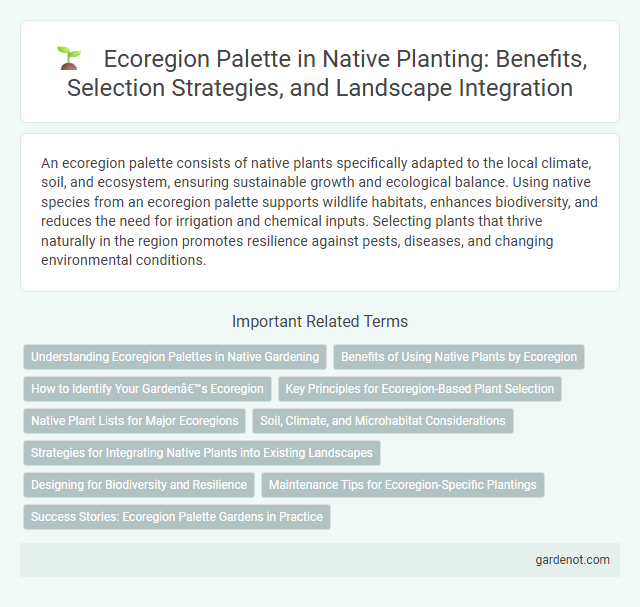An ecoregion palette consists of native plants specifically adapted to the local climate, soil, and ecosystem, ensuring sustainable growth and ecological balance. Using native species from an ecoregion palette supports wildlife habitats, enhances biodiversity, and reduces the need for irrigation and chemical inputs. Selecting plants that thrive naturally in the region promotes resilience against pests, diseases, and changing environmental conditions.
Understanding Ecoregion Palettes in Native Gardening
Ecoregion palettes in native gardening consist of plant species that naturally thrive within specific ecological regions, reflecting local climate, soil, and wildlife conditions. Selecting plants based on ecoregion palettes enhances biodiversity, supports native pollinators, and improves ecosystem resilience. Utilizing native species from the correct ecoregion palette reduces maintenance needs and increases garden sustainability by replicating natural habitats.
Benefits of Using Native Plants by Ecoregion
Using native plants tailored to specific ecoregions enhances local biodiversity by providing habitat and food sources for native wildlife species, promoting ecological balance. Native plants adapted to regional climates and soil conditions require less water, fertilizers, and pesticides, contributing to sustainable land management and reduced maintenance costs. Furthermore, ecoregion-specific native palettes improve soil health and resilience against invasive species, supporting long-term ecosystem stability.
How to Identify Your Garden’s Ecoregion
Identify your garden's ecoregion by analyzing local climate, soil type, and native vegetation patterns unique to the area. Utilize resources like regional ecological maps, USDA Plant Hardiness Zones, and state or local native plant guides to pinpoint the appropriate ecoregion palette. Matching plants to your garden's ecoregion ensures optimal growth, biodiversity support, and environmental sustainability.
Key Principles for Ecoregion-Based Plant Selection
Using an ecoregion palette ensures plant selections align with the native climate, soil, and ecological conditions, promoting sustainable growth and resilience. Key principles for ecoregion-based plant selection include prioritizing species indigenous to the local habitat, supporting biodiversity, and enhancing ecosystem services such as pollination and soil stabilization. This approach reduces water usage, limits invasive species, and fosters a balanced, self-sustaining landscape adapted to regional environmental factors.
Native Plant Lists for Major Ecoregions
Native plant lists tailored for major ecoregions provide essential guidance to restore and maintain local ecosystems by ensuring species compatibility with regional climate, soil, and wildlife. These curated palettes enhance biodiversity, support pollinators, and improve habitat resilience by using region-specific flora such as prairie grasses in temperate grasslands or hardwood species in forested ecoregions. Access to comprehensive native plant databases and regional conservation organizations facilitates sustainable landscaping and ecological restoration efforts aligned with ecoregion characteristics.
Soil, Climate, and Microhabitat Considerations
Selecting native plants based on ecoregion palettes ensures optimal growth by matching species to local soil types, climate conditions, and microhabitats. Soil pH, texture, and nutrient availability directly influence plant health and native species success in restoration projects. Climate factors such as temperature ranges, precipitation patterns, and seasonal variability, combined with microhabitat features like sun exposure and moisture levels, determine suitable native plant communities for sustainable landscapes.
Strategies for Integrating Native Plants into Existing Landscapes
Strategies for integrating native plants into existing landscapes prioritize selecting species from the local ecoregion palette to enhance biodiversity and ecosystem resilience. Utilizing native plants that are adapted to regional soil, climate, and hydrology reduces maintenance needs and supports native wildlife, pollinators, and soil health. Effective integration includes layering native trees, shrubs, and groundcovers to create multi-dimensional habitats that mimic natural plant communities.
Designing for Biodiversity and Resilience
Ecoregion palettes integrate native plant species adapted to specific regional climates, enhancing biodiversity by supporting local wildlife and pollinators. Designing with these palettes promotes ecological resilience through diverse plant communities that improve soil health, water retention, and habitat connectivity. Selecting plants native to an ecoregion reduces maintenance needs while fostering sustainable landscapes that withstand environmental stressors.
Maintenance Tips for Ecoregion-Specific Plantings
Ecoregion palette plantings require tailored maintenance strategies to support native species' growth and resilience. Prioritize watering schedules aligned with local rainfall patterns and soil moisture retention characteristics to reduce stress on native plants. Employ mulching techniques that enhance soil health while minimizing invasive weed growth, ensuring long-term sustainability of the native landscape.
Success Stories: Ecoregion Palette Gardens in Practice
Ecoregion Palette Gardens showcase the effectiveness of native planting by utilizing species tailored to specific ecological regions, promoting biodiversity and resilience. Success stories highlight enhanced pollinator habitats, improved soil health, and reduced maintenance compared to conventional gardens. These gardens demonstrate sustainable landscaping practices that support local ecosystems and foster environmental stewardship.
Ecoregion palette Infographic

 gardenot.com
gardenot.com